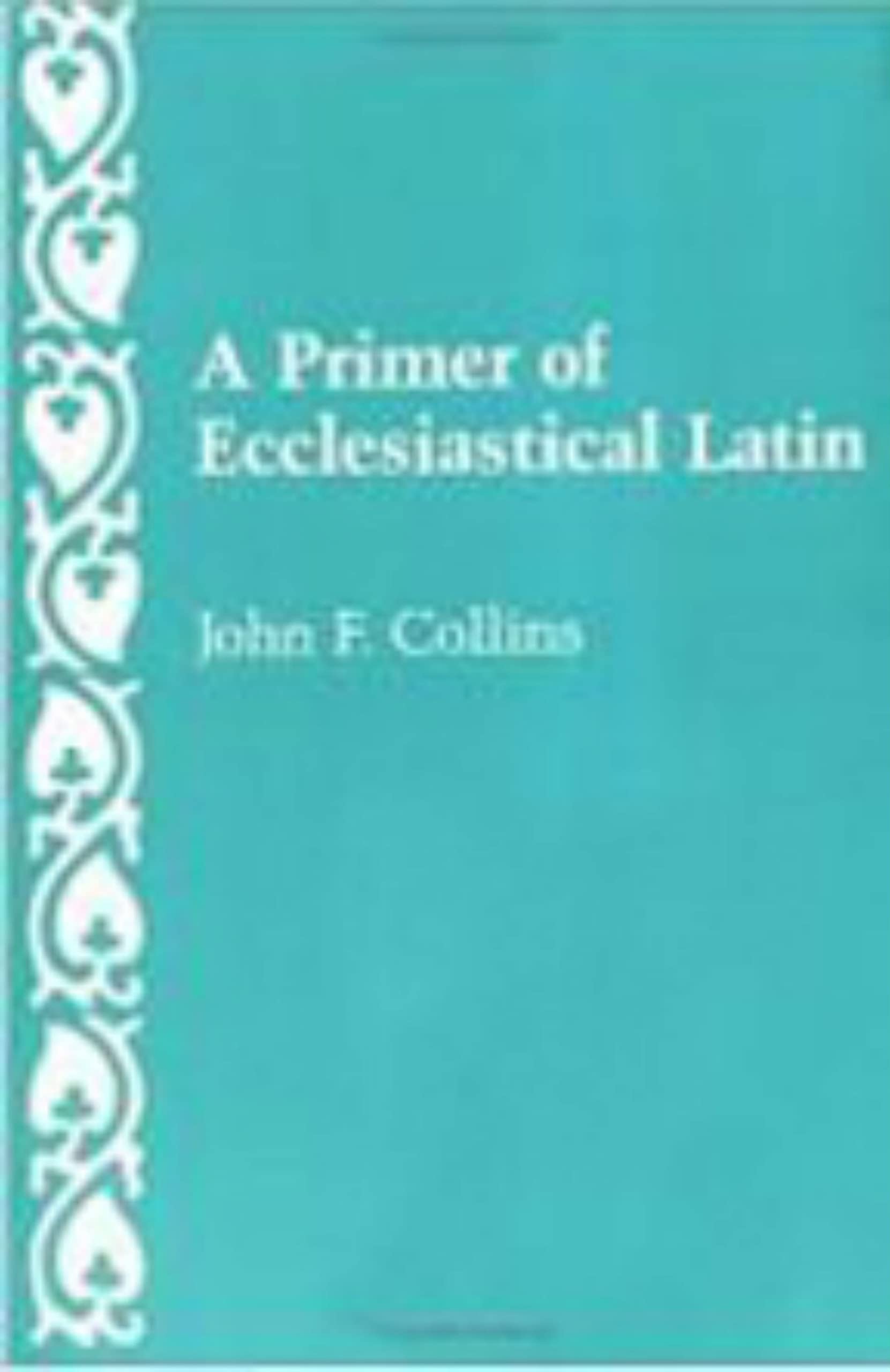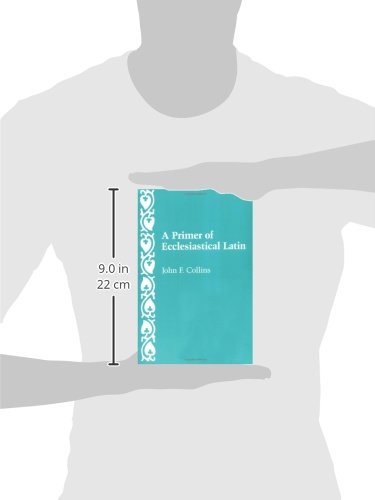



Full description not available
L**N
Ecclesiastical Latin: "A House of Many Mansions"
For anyone desiring to learn Ecclesiastical Latin, the "official" theological and liturgical language of Western Christendom, John F. Collins's A Primer of Ecclesiastical Latin is the standard textbook to accomplish this goal. Employing traditional pedagogical techniques, such as noun and verb paradigms as well as translation and composition exercises, Collins's Primer is intended for a two-semester college or seminary class. As Collins himself notes, "Of the thirty-five units of instruction in this text, perhaps twenty may be covered in one semester and fifteen in the next; this leaves approximately three to four weeks for continuous reading of selected original texts (such as Mark's Gospel)." This timeframe can easily be used (or adapted) for self-study as well.Collins's Primer begins with an overview of the pronunciation of Ecclesiastical Latin, which, in many cases, differs significantly from that of Classical Latin, the language of Vergil, Caesar, and Cicero. These variations, in fact, give Ecclesiastical Latin a marked "Italian" flavor. Chapter-by-chapter, each of which builds upon the prior, Collins then introduces the basic elements of Latin syntax and grammar as well as necessary vocabulary. Since Ecclesiastical Latin was developed by the early Christian Church, its vocabulary contains a number of words that were adapted from Classical Latin or invented all together for Church usage. A good example of the latter is "consubstantialis," an adjective meaning "of the same nature," which is crucial in defining the relationship among the Persons of the Holy Trinity in the Christian Creeds.Additionally, Collins introduces unmodified passages of the Vulgate Bible (the "official" Latin translation of the Catholic Church) and selections from liturgical texts in the earliest translation exercises. Indeed, by Chapter 21, sizable selections of each are offered for student translation. Following the concluding chapter of the text (Chapter 35), moreover, Collins includes a "Further Readings" section, which offers entire chapters of Luke's Gospel, the Order of Mass (Ordo Missae), and classic Christian poems from the Middle Ages. Lastly, the Primer contains a comprehensive and invaluable Latin-English/English-Latin Dictionary, for which the student of Ecclesiastical Latin will be extremely grateful; most available Latin dictionaries feature Classical Latin vocabulary usage only.I highly recommend Collins's A Primer of Ecclesiastical Latin, published by the Catholic University of America Press, to all students of theology as well as students of medieval and Renaissance history. The Catholic University of America Press also publishes a useful answer key to the exercises contained in the Primer (available separately).
E**5
Excellent Book for Latin Students!
I am a student taking Latin I classes and am using this series of books as they are recommended by the instructor. The book arrived in excellent condition and in a timely manner. I highly satisfied with the seller and highly recommend them.
Z**N
As Good As Wheelock's Latin
A very good textbook of Latin. This is as good as Wheelock's Latin. The pronunciation is a superfacial issue, no matter you prefer Classical pronunciation or Ecclesiastical pronunciation or any vernacular pronunciation. The essential grammar is almost the same.The book taught Latin in the same way as Wheelock's Latin. Grammar points are listed, and then practice is illustrated. The exmples are related to church usages instead of classical literature.
T**R
This book is the best
I bought Collins' book because I wanted to be able to pray the Divine Office in latin. Indeed this book has enabled me to do just that.When I bought Collins I already had the Wheelock textbook and "Essential Latin" by Sharpley, but I hadn't really studied from them. Both books concentrate on classical latin and Roman culture. However, to really learn latin I wouldn't recommend to use them first. As somebody else here already mentioned, the best is to complete all of the units in the Collins book, then you can go through Wheelock and any other latin book which you may have. From those other books you will at least review and reinforce grammar already learned, and also learn other vocabulary which isn't presented in the Collins.Ultimately I recommend the Collins book over the other two because Collins provides an abundance of practice and training in reading and comprehending latin texts. The first 10 units could be considered "light" and one is perhaps able to breeze through them in a matter of 2-3 weeks. Thereafter the units begin to offer more and more exercises and it therefore takes longer to complete just one unit.What I appreciated from this book is that the grammar was explained in a very "formal" or "scholarly" way. I never felt the author was "talking down" to the reader, no matter how difficult the concepts got. Also, the way the author designed this book was to force the pupil to think actively about the material. For example, the verbs "deficio", "efficio", "inficio", "interficio", proficio, etc. all share "facio" as their base, but add to it a prefix to form a new verb. If you wanted to look up "inficio" in the glossary, you would have to search for it under the "F"s under "facio" and not under the "I"s as it wouldn't be listed there. Annoying at first, I later came to appreciate this as it has made me become more aware of base verbs with their different possible prefixes (even in English too).All in all, my journey through this book took a lot of time and effort. I took the time to do ALL the exercises in each unit. At the end of each unit, I would carefully check each of my answers to that offered in Dunlap's Answer Key (this answer key booklet is a must, if you are serious about studying Collins). Learning from mistakes proved to be an invaluable contribution to my advancement in latin. I began working on the Collins in late January and finished by the end of June, with some pauses here and there.I must say that as a native speaker of Spanish, learning the latin vocabulary was overall a "breeze" and learning the grammar was "alright". If you have no background in any romance language and you have never studied any latin before, then I would recommend devoting some time just for vocabulary, in addition to that for the exercises.To conclude, I believe that everybody who wishes to learn latin, regardless if they wish to use church latin or not, should study the Collins book as it will provide a thorough and complete knowledge of how the latin language works.
A**S
First Class EL Grammar
This is the best grammar/translation method of learning Ecclesiastical Latin to be used. By the end of the grammar, you will be able to read important latin texts and engage with the Classical Latin Mass . This is a must have before you embark on reading Jerome's Biblia Vulgata. Highly recommend for any student of any age.
F**.
Producto Con detalle
Es una pena que el libro llegara con un pequeño detalle en la pasta, he comprado otros libros por este medio y han llegado muy bien, a excepción de este.De ahí en fuera todo bien, llegó un día antes de lo estipulado...Gracias.
J**G
Excellent for the beginner and for Roman Catholics wishing to know more about that faith
A truly excellent introduction to Ecclesiastical Latin which proceeds in a step by step fashion and concludes with excerpts from the Roman Missal, gospels, papal bulls and hymns.The only imperfection is the listing of conjugations. Bizarrely, the genitive is listed differently than in most grammars. Not a problem, but any editors would do well to emend this.
E**R
Learn latin at any age
Great book for learning Latin at any age.
C**L
Génial !
Je suis entièrement satisfait de ce livre. Jugeant que le latin et l'anglais ont une structure commune dans la forme grammaticale et syntaxique, je me trouve plus à mon aise pour assimiler la langue latine que j'adore.
Trustpilot
5 days ago
1 week ago